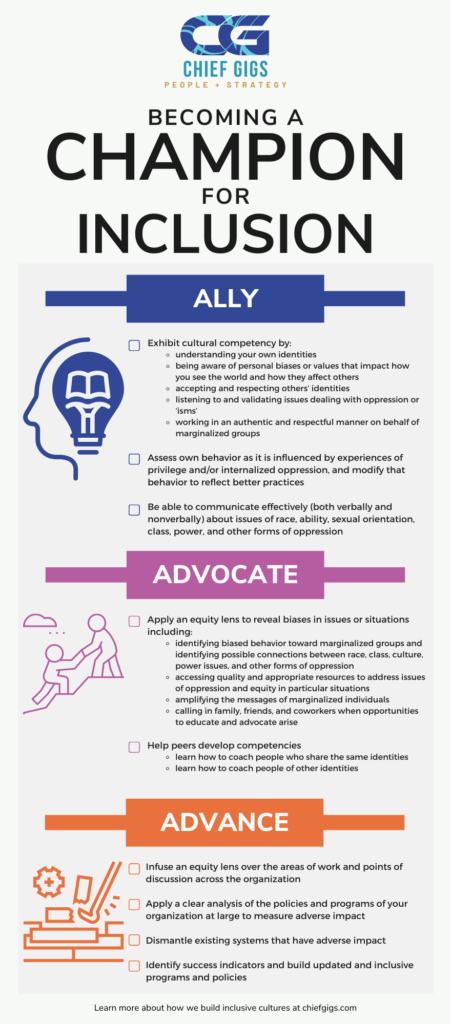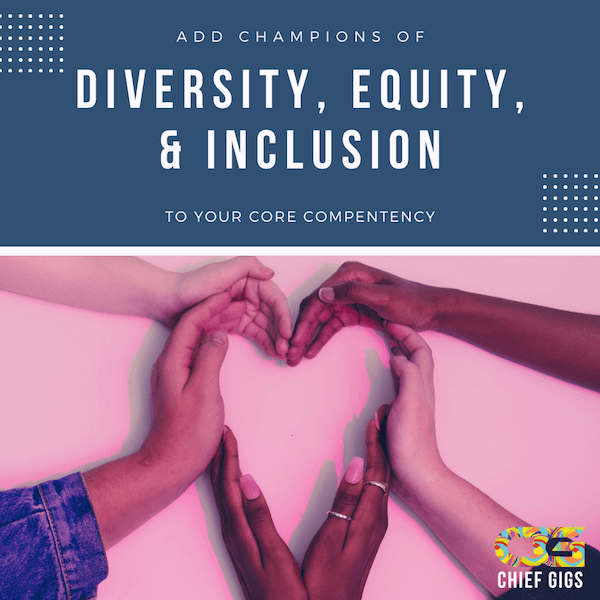This is part 2 of a 3-part series. Read the introduction and part 1.
Obviously, it’s not as easy as it sounds. This may be the hardest of the three steps. It takes a great deal of dedicated time, intentionality, and leadership support to achieve inclusion. One DEI training is not a panacea. In fact, there’s plenty of research that shows lack of positive results for bias and diversity training. What I’m suggesting here is not one, or even a series, of training for your staff. What needs to happen is that the organization needs to infuse DEI into its very fabric.
To achieve champion status, we must first look at some definitions.
This graphic by designer and illustrator Tony Ruth @lunchbreath explains it well.

Additional definitions:
Core competency – a defining capability or advantage that distinguishes an enterprise from its competitors.
Inclusion – the act of creating environments in which any individual or group can be and feel welcomed, respected, supported, and valued to fully participate. An inclusive and welcoming climate embraces differences and offers respect in words and actions for all people.
Now that we’ve gotten the basics out of the way, know that the ultimate goal is to create an inclusive environment free of hostility, toxicity, and adverse impacts to marginalized identities.
There are three achievement levels on an employee’s journey to being a champion.
Level 1 – Employees should be able to:
- Exhibit cultural competency by:
- knowing how to listen to and validate issues dealing with culture and various forms of oppression or ‘isms’ and be able to send and receive appropriate nonverbal and verbal messages and responses.
- knowing one’s own culture and position and being aware of personal biases or values that may affect others.
- accepting and respecting others’ cultures, practices, and beliefs.
- working in an authentic and respectful manner on behalf of other cultures and differences.
- Assess his/her own behavior as it is influenced by experiences of privilege and/or internalized oppression and modify that behavior to reflect better practices.
- Communicate effectively about issues of race, class, power, and other forms of oppression or ‘isms’ (e.g., demonstrating a comfort level with talking about these issues) and be able to send and receive appropriate nonverbal and verbal messages and responses.
Level 2 – Employees should be able to:
- Apply an equity lens to reveal biases in an issue or situation. This includes:
- Identifying and addressing biased behavior toward target groups and identifying possible connections between race, class, culture, power issues, and other forms of oppression.
- Judging the quality, relevance, and appropriateness of resources for addressing issues of race, other forms of oppression, and equity in particular situations.
- Help others develop competencies.
- First level competency – learn how to coach people of the same race, ethnicity, class, sexual orientation, etc.
- Second level – learn how to coach people of other ethnic, class, and sexual orientation backgrounds.
Level 3 – Employees with advanced competencies should be able to:
- Infuse an equity lens over the areas of work and points of discussion across the organization.
- Apply a clear analysis of ’embedded racial inequities’ and accumulated advantage (privilege) and disadvantage (racism) to the work of the organization at large and specific to a unit or program.
How might you start identifying or training champions in your organization?

Want more information on Becoming a Champion of Inclusion? Download the resource here!
Read the last part of the series on Creating Management Accountability Structure.

